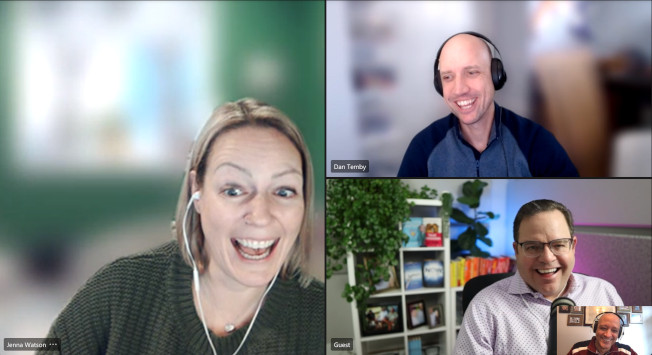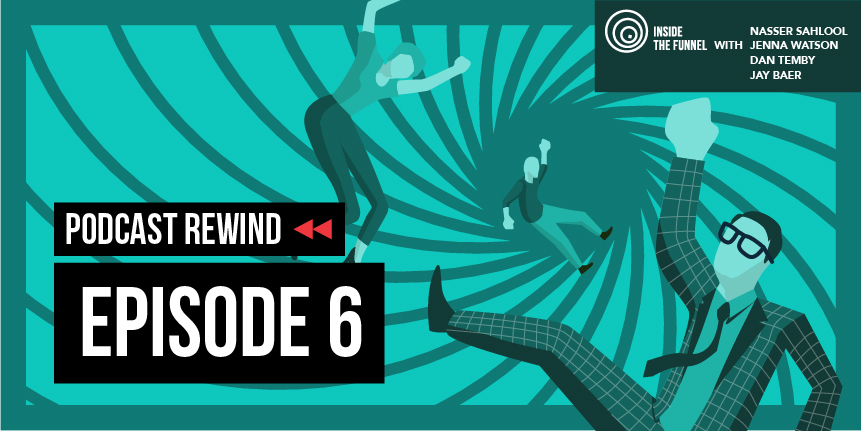In the latest episode of Inside the Funnel, Dan, Nasser, and Jenna set their sights on one of digital marketing’s most elusive and nuanced topics: customer experience (CX). And who better to grill than the world’s most inspirational CX keynote speaker (and certified barbecue judge), Jay Baer?
Jay set the bar as the podcast’s first ever guest, revealing eye-opening facts, observations, and lessons from his unparalleled experience. These are his hottest takes as marketers the world over adjust to the new normal—and start to appreciate the growing importance of CX in all industries.

-
Experience matters more than ever
As a direct result of the pandemic, more people are making first-time purchases from businesses they’ve never previously dealt with. At the same time, divorce rates are up 34% and rising. The lesson is: if the world has become unpredictable, you might as well consider all your options.
Of course, switching suppliers for anything has historically been a hassle, but “switching costs” aren’t usually front-of-mind for anybody with a wandering eye. As of 2021, consumers are suddenly much more likely to defect to a competitor—so, by the same logic, your competitor’s customers are now also more likely to defect to you. This shift has not been driven by economics but by experience. “Who is easiest to deal with? Which option makes me most comfortable?”
As online shopping becomes a pastime in its own right, it has significantly lowered the barrier to entry for new businesses. In this new normal, even the slowest adopters are comfortable shopping on social, taking a chance on those comfy-looking slippers from the brand they’ve never heard of, and seeing what shows up in the mail. Don’t want your customer base to start eyeing your rivals? Experience matters.
-
Most CX initiatives fail
It’s estimated that 70% of CX initiatives fail to produce ROI. It’s not due to a lack of enthusiasm for CX, but because organizations tend to treat CX like a standalone thing. In fact, CX is the culmination of dozens or even hundreds of everyday business decisions. The most effective initiatives are small scale; they stop, start, or change something tangible to make CX better. And because even the most ambitious undertakings start with simple steps (as we explored in our omnichannel episode), it’s better to get something modest in the water rather than embark on yet another ocean-boiling exercise.

CX is an abstraction of hundreds of things you do correctly (and incorrectly), and even the savviest CMOs often get the wrong end of the stick when they claim that “soft” channels like social aren’t measurable. The problem, in fact, is that they’re too measurable. Although we’re surrounded by data like never before, we’re also starved of insights because we struggle to tie any of it back to business outcomes. It’s not about big data—it’s about big understanding.
-
Three keys to effective CX
Divorce lawyers, slipper manufacturers, the RV and fishing industries… Not everyone has suffered a downturn over the past year and more. The next challenge for these fortunate few is to offer experiences that generate loyalty (and new business) in a world where customers are more inclined to hop from one supplier to another. As Jay puts it:
It’s not about being the cheapest and it’s not about customer experience as an abstract. You have to focus on the things that customers care about disproportionately… In frankly every industry, the three things customers really care about: they want you to be quick, they want you to be clear, and they want you to be kind… Put specific programs in place to be incrementally better at those three areas of CX, you will be well on your way to succeeding.
-
Measuring CX objectives
You may have an impressive CX metrics stack in place—CSAT, NPS, CES, recurring revenue, pass-along rate—but, as we’ve established, the most effective CX initiatives are both simple and achievable.
For instance, you may give yourself 90 days to become 15% faster in your customer responses. Take the simple steps needed, then run pre- and post-testing. Happy with the outcome? Set yourself a similar challenge and divorce the variables, just like an A/B test or multi-variant test. You can’t change six things at once.

Remember, though, to view your numbers from a correlative perspective, not causative. The idea that answering the phone or responding to review faster will contribute directly to revenue gains is fanciful, but patterns will emerge over time. So, while you may not be able to definitively prove that responding to emails quickly results in revenue, it seems to happen anyway… so keep doing it.
-
CX for retention vs. CX for acquisition
Customer retention is typically rooted in competency: avoiding mistakes, communicating clearly, following up. It’s critical because it reduces churn, but there’s a growing notion that competency doesn’t create conversations. Nobody ever raves about restaurants, retailers, and other businesses that are simply adequate. That’s why you don’t see a lot of three-star reviews.
Because we all have this tendency to discuss things that are different and ignore things that are average, brands are incentivized to give their customers a story to tell and turn them into volunteer marketers. Service then becomes the key ingredient, especially for reviews, because it fluctuates far more than products.
Jay’s classic example is Bogdanoff Dages and Co., P. C., a small Indianapolis accounting firm that offers the same solutions as 10,000 other similar businesses in the US—personal returns, small business returns, tax advice—but leans heavily into the “quick” aspect to set itself apart. They respond to every client on every channel within five minutes; a perk rarely expected or experienced in accounting. The result? Free marketing in the form of an unusually large number of positive reviews across various platforms, most of which specifically call out speed of service.
Listen, learn, luxuriate
Geek Squad founder Robert Stephens famously remarked that “advertising is a tax paid by the unremarkable”. That’s not entirely true, of course—there’s still a time and place for advertising—but the fact remains that the most successful brands advertise the least because their customers do that job for them. Only, however, if they have a story to tell.
But don’t just take our word for it: put the kettle on and hear it from the man himself. You’ll immerse yourself in Jay’s wit, charm, and insight; learn about the increasingly important “uncertainty gap”; and hear how Delta Airlines sent Jay and his wife down the runway in tears (in a good way). Listen now on Spotify, Apple Podcasts, Google Podcasts, Amazon Music, or wherever you get your podcasts!




